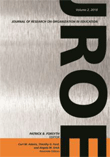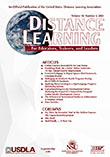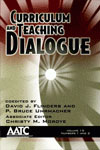
Journal of Research on Organization in Education
AUTHOR GUIDELINES FOR MANUSCRIPT PREPARATION
Manuscript Submission Guidelines
- Submit “blinded” manuscript as a single document attachment to a cover submission email message to patrick.forsyth@ou.edu
- The body of the manuscript should not exceed 30 pages double-spaced (i.e., not including references, notes, tables, and figures)
- Manuscripts should be prepared using the Publication Manual of the American Psychological Association, 5th or 6th Edition
- Submit your manuscript electronically via email to patrick.forsyth@ou.edu
- All files (except figures) should be in Microsoft Word, double-spaced. Do not justify or apply hyphenation, outlining, or any other formatting
- Substantive abstract of 150 words or fewer
- Text manuscript: Add page numbers. Be sure the manuscript includes all of the following elements: references, chapter appendices, footnotes, tables, exhibits/boxes/cases, figure captions. Place these at the end of the text portion of the manuscript (no need to break these out separately)
- Figures: Identify each figure with a number (e.g., Figure 1.1) and figure title; an example: “Figure 3, Nursing Procedures.” Place all figures in the folder. See below for more information regarding figure preparation and citation in text
- About the Author (required): A brief (1-2 paragraph) biography of each author
SPECIAL TEXT FORMATTING INSTRUCTIONS
Headings
Type your chapter headings in a consistent style to ensure correct interpretation by the copyeditor and typesetter. All headings should be on a separate line and not run into the text.
TYPE NUMBER 1 HEADS IN BOLD/ALL CAPS
Type Number 2 Heads in Bold, Italics/Title Case
Type number 3 heads in bold, italics/sentence style
Type number 4 heads in italics/sentence style
Italics and Boldface
New or special terms are often highlighted by italics, boldface, or boldface italics. Whichever you choose, please be consistent throughout your manuscript.
Units and Abbreviations
Always leave a space between a number and a unit, e.g., 5 mm. Use abbreviations that are accepted nomenclature and use them consistently. Define all abbreviations and acronyms at the first point of use, e.g., cyclic adenosine monophosphate (cAMP).
Quotations
• A direct quotation of not more than 4 or 5 lines should be enclosed in quotation marks and run into the text.
• Longer quotations should be indented at least 5 spaces from the rest of the text from the left margin, double spaced, and without quotation marks.
• Use ellipses (...) to indicate any point in a quote in which you have omitted any material. If the omission occurs at the end of a sentence, use 4 dots, the last being the period.
• If you add italics for emphasis to material within the quote, indicate it with a footnote: “Italics mine.”
• If you add material to a quotation, place your own words within brackets, not parentheses. Parentheses should appear only as used by the original author.
• Check each quotation to ensure that it is verbatim.
Tables
• Use tables when content can be more effectively presented in this format, especially when comparisons are intended.
• Presentation of tables should be as simple as possible. A table that is long but has few columns is preferred to a wider table with many columns.
• Feel free to use horizontal and vertical rules to clarify alignment for our copyeditors and typesetters.
• A summary of the findings in a table should be discussed in the text. Always cite tables formally in text using the number system (e.g., see Table 1) and not “see table below.”
• Always double-check your tables for accuracy, recalculate any totals, and proofread them carefully.
• Group all tables together at the end of the manuscript.
Mathematical Equations
• All math equations must be set in Math Type and NOT Word Equation editor.
Figures and Illustrations
• Keep your illustrations as simple as possible. Avoid large black areas and/or very dense patterns; they will not reproduce well.
• Make sure all figures and illustrations serve an academic or pedagogical purpose. Illustrations that are purely decorative or unnecessary should not be used.
• All figures and illustrations will be converted to and printed in black and white. If color illustrations are required, discuss this in advance with your editor.
• Like Tables, Figures should be numbered consecutively (in order of appearance). All figures must be cited, either parenthetically or in the text.
• Limit use of gray tones in charts or graphs. An acceptable selection of gray tones is 20%, 50%, 80%.
Figures Submitted Electronically
• Line art should be submitted or scanned at 600 to 1200 dots per inch (dpi).
• Halftones (photos) should be submitted at 300 dpi and must be saved as TIF files.
Note: An easy way to check resolution of line and halftone figures is to use Microsoft Office Picture Manager. (Open the file in MS Picture Manager; right click on the image itself, select PROPERTIES, then MORE under Picture Properties. The dpi will display.
Figures Submitted as Hard Copy
• If you cannot supply electronic versions of your figures, supply good-quality hard copies (printed at 1200 dpi on laser paper).
• Below each figure, outside the area of the figure itself, write the figure number, your name, the title of the book, and any notations (indicate the top of the figure if there could be doubt about its correct orientation).
• Again, IAP uses the Publication Manual of the American Psychological Association, 5th or 6th Edition as our default for citing references.
• A reference is a source that is actually cited in the text. If the source is not cited in the text, it should be placed in a section of Additional Readings or a Bibliography. Sources in these sections should be unnumbered and typed in alphabetical order by author.
• NOTE: Do not use the automatic reference feature in Word or reference tools like EndNotes®; these are not compatible with our typesetting systems.
Do a final check of the manuscript before submission for completeness and accuracy.
____ A substantive abstract of 150 words or fewer.
____ An electronic version (Ms Word) of the manuscript – all text, references, tables, figure captions with source lines, figures, etc.
____ Complete data for each author: full name, credentials, title, and affiliation; full mailing address including street address, city, state, zip code; email address; and phone number.
____ Figures clearly labeled with author's name, title, figure number, and with “top” clearly indicated.
____ IAP’s Contributor Release, signed by the author (must be submitted prior to publication).
The SoJo Journal
Educational Foundations and Social Justice Education
Middle Grades Research Journal
A Research Journal Published by the Institute for School Improvement







